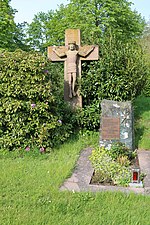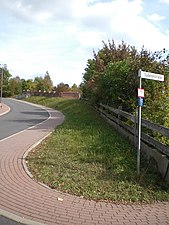Giesel cemetery
The Giesel cemetery is located in Giesel , a district of the Neuhof community . It has served as the town's burial site since the beginning of the 20th century . It is located in the municipality of Neuhof (near Fulda) in the eastern Hessian district of Fulda .
history
For centuries, the dead of the village of Giesel were buried in the churchyard of the chapel built around 1330 by Würzburg canon Nikolaus Roslon, which was consecrated to St. Mary Magdalene . The church was made of solid stone. From 1594 onwards it was called the castle chapel , which was assigned to the parish of Haimbach and was surrounded by a churchyard wall made of sandstones .
This old cemetery at Zellertstrasse 6 was deedicated and leveled in 1959 . Later a residential building was built.
At the beginning of the 20th century in 1908/1909, today's cemetery was laid out and surrounded by an enclosure wall made of burned bricks. The address of the cemetery “ Zellertstrasse ” indicates that it was created outside the built-up area. In 1960 the cemetery had become too small for a cemetery chapel to be built. An extension followed as part of a land consolidation for the construction of the chapel. Further grave sites were created on the valley side of the cemetery chapel.
Second expansion of the cemetery
A second expansion took place under Mayor Martin Hohmann with the creation of a landscape cemetery east and above Sudetenstrasse at the end of the 1990s. With the planning of the garden architect Klaus Heigl from Poppenhausen , part of the cemetery area in the grave field "family graves" was planned with deep graves and laid out with 2 locations one above the other. The first burials took place from May 1997.
Relocation of the main entrance
In 2013 the main entrance gate, which had been in use for over 100 years, was relocated and closed with bricks.
The expansion of Zellertstrasse with sidewalks on both sides made this relocation necessary because of the height difference. The access road, originally designed as a long access ramp (today's green strip next to the right sidewalk) from 1909, was relocated from the corner of Sudetenstrasse and Zellertstrasse uphill to the northeast.
Cemetery chapel
Please refer
Cemetery bell

In the war year 1917, two bells from the old parish church of St. Laurentius were confiscated for the manufacture of armaments. The bells of the 19th century in particular had to be delivered to be melted down. The same thing was repeated in the Second World War in 1942. The two bronze bells "Josef" and "Maria", which had to be sent to the central bell cemeteries in Hamburg, were affected . In the post-war years of 1922 and 1950, the bells that were melted down in both world wars were replaced.
After the inauguration of the cemetery chapel in 1962, the Laurentius bell from 1950 that was still present was installed in the bell carrier.
New cemetery cross and graves of honor
At the same time, the new cemetery cross was made of red sandstone by the sculptor Siegfried Fleck , (Fulda). The caption reads: “ I am the resurrection and the life ” John 11: 25-26 LU .
Next to the cemetery cross is the honorary grave of Pastor Josef Schminke, who worked from 1984 to 1989 and who died here, on the right. Not far from the main entrance gate of the cemetery (left) is the grave of honor of the main teacher and long-time cantor of Giesel Christoph Kalb .
War grave from 1945
During the advance of the US armed forces of the 11th Panzer Division on March 31, 1945 from the direction of Hosenfeld and Hauswurz over the Sieberzmühle - in the direction of Fulda - seven Wehrmacht soldiers were killed in the Easter days of 1945 during military purges in the great Gieseler Forst around Giesel:
| Rank | Surname | born |
|---|---|---|
| First lieutenant | Werner Busch | October 15, 1910 in Birkenfeld |
| Sergeant Major | Erich Haaker | August 19, 1915 in Halle |
| sergeant | August Büntge | June 25, 1898 in St. Andreasberg |
| Sergeant | Franz Fislage | May 28, 1917 in Ibbenbueren |
| Sergeant | unknown | unknown |
| Corporal | Franz Ebert | October 20, 1912 in Simmershausen |
| Corporal | Wilhelm Butterweck | October 15, 1900 in Lüttersheim |
All of the dead were brought to the cemetery in Giesel by horse and cart. There they were buried in the common grave on April 12, 1945 and consecrated by the pastor Valentin Haas with the participation of the Giesel population. For fear of the “Jabos” (fighter bombers), the funeral at the Gieseler Friedhof took place at 7 o'clock in the morning.
Reburial:
In 1980/81 the Neuhof community, with the participation of the Volksbund Deutscher Kriegsgräberfürsorge eV in Kassel, carried out seven reburies from three private war graves into the existing community war grave. These graves were leveled with the expiry of the deadline for the grave field on the southeastern cemetery wall near the new terrace-shaped structure. They were those of Corporal Alois Eidmann, who died from a war wound after a stay in a hospital, whose name was added to the existing grave monument .
The names of the two graves of civilian war dead from Giesel were recorded on the granite grave slab added in 1981 . They had to lose their lives in air raids on Fulda. It concerns the members of the whole Ender family who were named as civilian victims of the air raids in the " Krätzbachtunnel " and the Maria Seng in the city area "Am Pröbel" below today's youth hostel for posterity.
Coordinates: 50 ° 30 ′ 6.5 ″ N , 9 ° 34 ′ 25.9 ″ E







